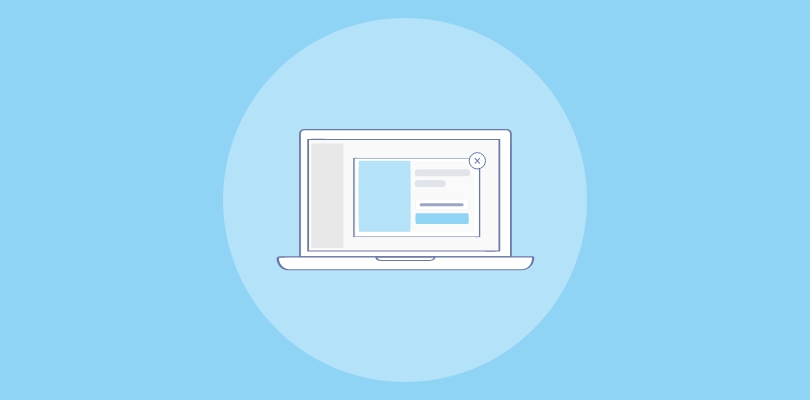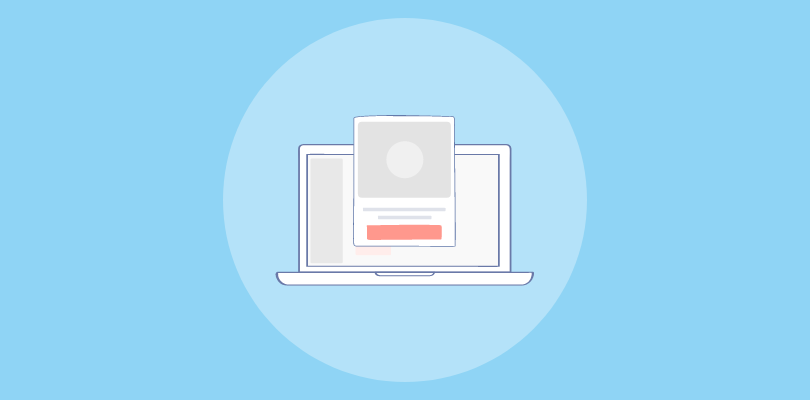Popups are one of the most effective ways to grow your e-commerce business. They can help you capture leads, increase sales, and build long-lasting relationships with your audience.
But there’s a catch: you have to show them at the right time.
Timing is everything when it comes to popups. If you show them too early, you’ll interrupt your visitors and make them bounce. If you show them too late, you’ll miss the opportunity to engage them and make them stay.
So how do you find the sweet spot for your popup timing?
That’s what this blog is all about.
In this post, we’ll share the best practices for popup timing and some proven tips to optimize your popups for maximum conversions.
Read on to learn how to use popups like a pro and skyrocket your e-commerce business.
What Is Popup & Popup Timing?
Popups are content overlays on websites during a visitor’s browsing experience. Website owners program these overlays to serve a specific purpose and appear without any action from the visitor.
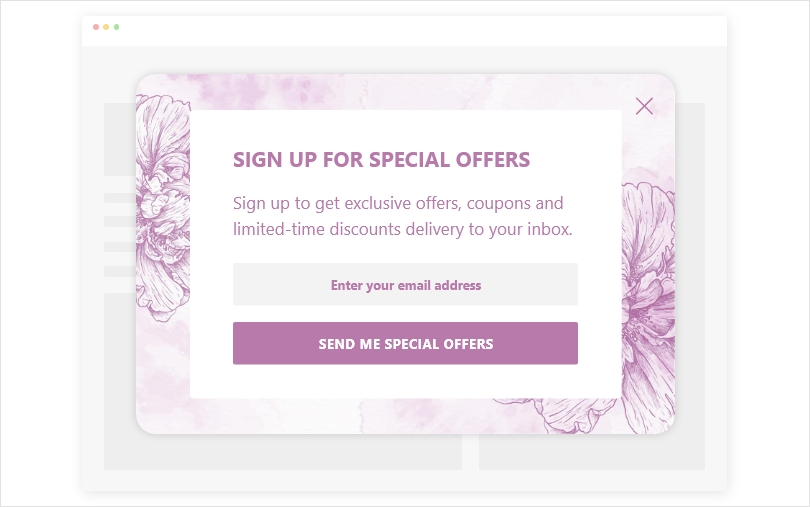
Popups may seem intrusive, but they can work wonders if you craft them carefully. Visitors are more likely to convert if you entice them with irresistible value.
Popup timing, on the other hand, refers to the specific moment during a visitor’s browsing experience when the popup is displayed. Website owners customize this timing to capture the visitor’s attention effectively.
Website owners can maximize their chances of engaging visitors and achieving desired results by optimizing popup timing.
Wondering why is it important to display popups at the right time?
Let’s find out!
Why Is It Important to Display Popups at the Right Time?
There’s no denying that popups can be pretty challenging to get right. Their disruptive nature sets them apart from unobtrusive sidebar forms and popups. You need to nail your popup timing to prevent annoying your visitors and losing them forever.
Aside from making popups visually appealing and offering valuable deals and offers, timing is of utmost importance. Displaying popups before the optimal time may not capture your visitors’ interest as they are still exploring what they want from your brand.
On the other hand, showing popups after the optimal time could cause you to miss out on many visitors who might leave before interacting with them.
Furthermore, it’s essential to remember that popups are naturally intrusive, so using them too frequently is a big no-no. You wouldn’t want to annoy your visitors and risk them spreading negative word about your brand.
To sum it up, failing to consider timing can lead to missed opportunities and, if overdone, can even cause harm. Hence, it is imperative to determine the optimal timing for popups.
Now that we understand the importance of displaying webiste popups at the right time let’s explore some proven strategies for determining the optimal moment to showcase them.
The Art of Timing Popups: Strategies for Success
Display popups can be an effective tool for capturing the attention of your website visitors and encouraging them to take specific actions. We’ve compiled a list of strategies sure to make a lasting impression to help you optimize your popup timing.
Analyzing User Behavior & Engagement
Regarding popup timing, the two most important questions you should answer are:
- What is your goal?
- Who is your audience?
Decoding the perfect popup timing begins with understanding your audience. Analyze user behavior and engagement patterns on your website.
Dive into metrics like time spent on each page, scroll depth, and click-through rates. This data will provide valuable insights into when visitors are most receptive to popups. By aligning popup triggers with user behavior, you can strike the right chord and capture their attention opportunely.
Let’s say you want to create an email popup for your new visitors to extend your audience base for marketing efforts. In that case, your goal would be to get more email signups, and your target audience would primarily consist of all first-time visitors.
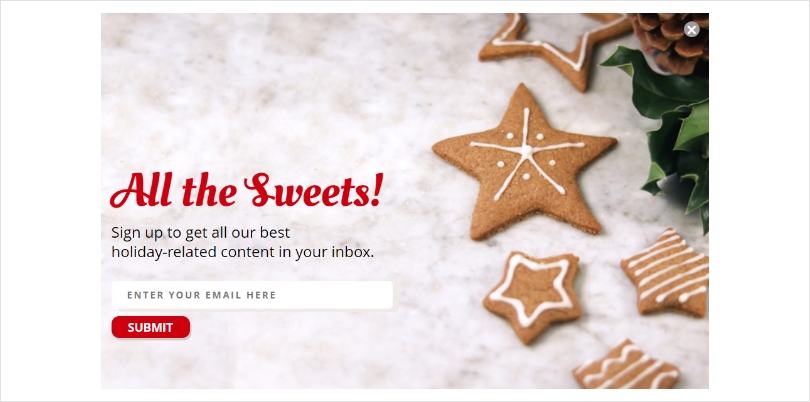
Leveraging Data & Analytics for Insights
Numbers don’t lie, and data-driven decision-making is key to nailing popup timing. Leverage the power of analytics tools to dig deeper into your website’s performance.
Look for peak traffic hours, popular pages, and conversion rates for different periods. This information will help you identify the optimal time slots to display popups and maximize their impact.
So start by identifying the peak traffic hours on your website. This will reveal when your website receives the highest number of visitors, indicating periods of increased user activity and engagement. By aligning your popup displays with these peak hours, you can target a larger audience and increase the chances of capturing their attention.
Next, analyze the performance of your popular pages. These are the sections of your website that attract significant visitor traffic and engagement. By tracking the conversion rates specific to these pages during different time periods, you can identify patterns and trends. This helps in selecting the optimal time slots to display popups on these high-performing pages, maximizing their visibility and impact.
Lastly, consider the conversion rates for different time periods. By comparing conversion rates during various hours or days of the week, you can uncover patterns of user behavior and identify periods when visitors are more likely to take action. This knowledge allows you to strategically schedule your popup displays during these high-converting periods, increasing the likelihood of driving conversions.
Let data guide you toward aligning your marketing efforts with the most promising windows of opportunity.
The data analyzed from Chartbeat of 25 million users across the web suggests that web engagement peaks right after the visitor scrolls below the fold.
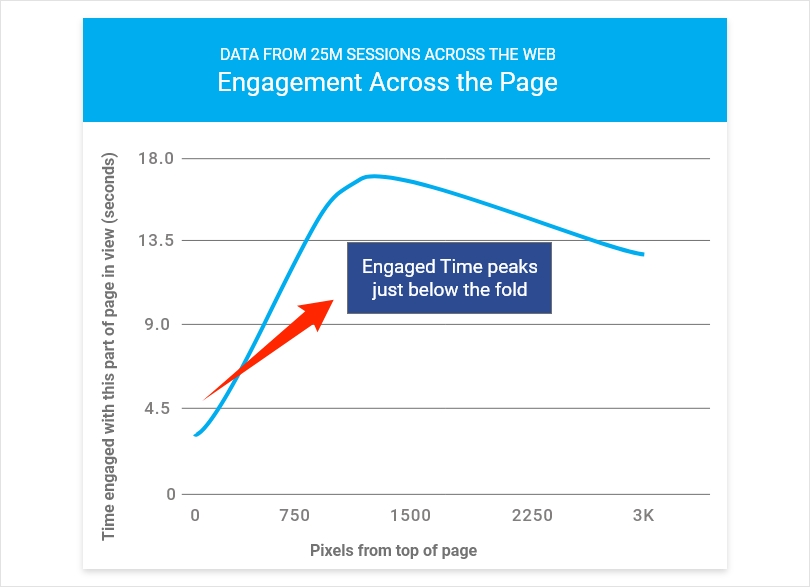
The pixels at the top of the screen are viewed for the shortest time, and the number rises as we go down the page.
This is why it is best to display the popups right after the peak engagement so that your visitors have enough time to get accustomed to your content and get enough value out of it.
You can use tools like Google Analytics or Crazy Egg to see where the peak engagement lies on your website and then target your popups immediately after those areas.
Setting this up is also extremely simple. You can use online popup builder like Picreel with advanced targeting features built-in, allowing you to customize your popup timing based on scroll behavior.
Implementing A/B Testing for Refinement
Why rely on guesswork when you can experiment and refine your popup timing? Implement A/B testing to compare different timing strategies and measure their effectiveness.
Divide your audience into groups and display popups at varying intervals or moments. Analyze the results and gather feedback to determine which timing resonates best with your users. A/B testing empowers you to fine-tune your approach and find the magic window that captivates visitors without causing annoyance.
However, it’s important to be aware of common mistakes when conducting A/B testing for popup timing:
- Testing Multiple Elements Together: To accurately assess the impact of timing, it’s essential to isolate it as a variable. Avoid testing multiple elements simultaneously, such as content or design changes, as this can confound your results. Focus solely on timing to understand its individual effect on user behavior.
- Testing for Incorrect Time Duration: Ensure that you allocate an appropriate testing duration. A short timeframe may not provide sufficient data for meaningful insights, while an excessively long duration can delay improvements. Consider factors like traffic volume and desired statistical significance to determine the ideal duration for your A/B tests.
- Using Unbalanced Traffic: When conducting A/B tests, it’s crucial to evenly distribute traffic between test groups to avoid biased results. Unequal traffic allocation can skew the outcomes, rendering your findings unreliable. Utilize randomized assignment techniques to ensure equal exposure of users to different timing variations.
You can precisely refine your popup timing strategy by avoiding these common mistakes and harnessing the power of A/B testing.
Utilizing Behavioral Triggers for Contextual Timing
Want to make your popups feel like a natural part of the user experience? Harness the power of behavioral triggers for contextual timing. By tracking specific actions, such as scroll depth, exit intent, or mouse movement, you can trigger popups at the precise moment when users display intent or interest. Whether it’s offering a discount code as they’re about to leave or suggesting a complementary product after a certain behavior, contextual timing enhances engagement and boosts conversions.
Once your visitors go through different product pages of your website, the chances of them making a purchase increase significantly. This is where you can focus specifically on your audience that moves further down your sales funnel.
Realistically, you cannot target steps of the sales funnel, but targeting specific pages that are a part of the sales funnel will do the trick.
This is where your popup timers or triggers will come in handy.
You can start by selecting specific pages of your sales funnel for the popups and then use trigger-based deployment for perfect popup times for maximum impact.
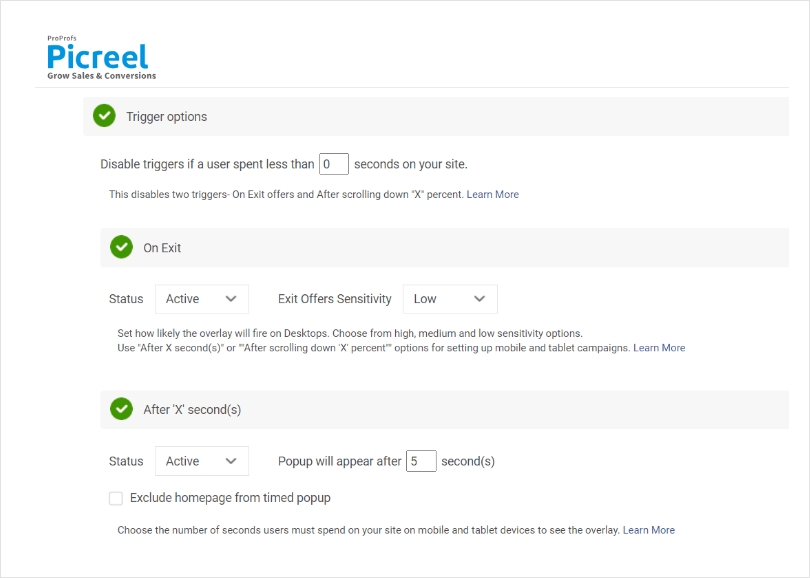
Your triggers can be based on timing, scrolls, exit intent, or even by clicking on website elements like images and text.
Also, sometimes these popup timers may not completely correspond to your sales funnel, but the fact that your users have traveled deeper to your product pages would mean that you have their attention.
At this stage, giving them exciting discounts and coupon codes can be helpful as they are at the last stage before conversions, and even the slightest push may help them convert.
Now that we have covered how to find the best timing for popups, let’s finally take a look at some quick tips for displaying popups.
Read More - 12+ Best Exit Popup Software
Pro Tips for Using & Timing Popups Effectively
To help you make the most of your popups; we’ve gathered some pro tips that will keep your visitors engaged, improve user experience, and ultimately boost your conversions.
Offer Value With Clear Benefits
Ensure your popups offer clear value and benefits to your visitors. Whether it’s a discount, exclusive content, or a free resource, make sure the offer is enticing and relevant to your target audience.
For instance, an e-commerce website could offer a popup with a 10% discount on the visitor’s first purchase, emphasizing the immediate benefit of taking action.
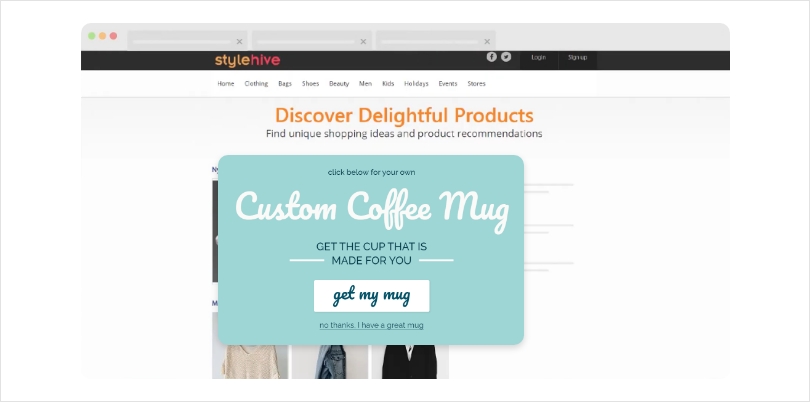
Keep It Simple & Concise
Avoid overwhelming your visitors with complex or lengthy popups. Keep the message simple and concise. Focus on the key benefits or call to action. Use attention-grabbing headlines and compelling visuals to convey your message quickly.
So a software company could use a simple popup with a headline that reads, “Boost Your Productivity Today” and a clear call-to-action button saying, “Get Started Now.”
Implement Smart Targeting
Use advanced targeting options to show your popups to the right audience at the right time. Consider factors such as demographics, browsing behavior, referral source, and previous interactions with your website.
For example, an online fashion retailer could display a popup offering personalized style recommendations based on the visitor’s previous browsing history and preferences.
A/B Test Different Popups
Experiment with different popup designs, copy, timing, and offers by conducting A/B tests. This allows you to gather data and insights on what works best for your audience. Test variations of popups with different colors, layouts, and wording to find the most effective combination.
A travel agency could A/B test two different popups—one offering a discount on flights and the other promoting a vacation package—to determine which drives more conversions.
Leverage Exit Intent Sensibly
Exit intent popups are powerful but use them wisely to avoid annoying your visitors. Craft a compelling offer or message that entices users to stay or take action before leaving.
For instance, a SaaS company could display an exit intent popup with a message like, “Wait! Before You Go, Get a 7-Day Free Trial” to convince the visitor to reconsider leaving.
Set Frequency Caps
Prevent popups from becoming intrusive or frustrating by setting frequency caps. Limit the number of times a display popup appears to the same visitor within a specific time period. This helps maintain a positive user experience while still allowing you to capture attention.
For example, you can set a frequency cap of once per session or once per week to avoid overwhelming your visitors.
Following these pro tips can create effective popups that engage your audience and drive conversions. Finding the right balance between providing value and respecting your visitors’ needs is key to successful popup implementation.
Read More - 11 Pop-Up Best Practices to Drive Conversions
FREE. All Features. FOREVER!
Try our Forever FREE account with all premium features!
Optimal Timing for Different Types of Popups
Let’s dig into the optimal timing for different popups.
Email Popups: Maximizing Newsletter Subscriptions
Email popups can be a highly effective tool to capture your visitors’ attention and encourage them to sign up for your newsletter. However, to maximize the impact of these popups, it’s crucial to consider the optimal timing for their appearance.
A key strategy is to trigger email popups when visitors have engaged with your website for a certain period of time. This ensures that they have had enough exposure to your content to make an informed decision about subscribing to your newsletter.
By carefully timing your email popups, you can strike a balance between capturing the attention of your visitors and avoiding an intrusive user experience. Remember, it’s essential to test and refine your timing strategy based on your specific audience and website dynamics to achieve the best results.
Video Popups: Enhancing User Experience & Engagement
Video popups can be a powerful tool for captivating users, but timing is crucial to strike the right balance.
Display video popups at strategic moments when they enhance the user experience, such as after a visitor has engaged with your content or shown interest in a particular topic.
Avoid interrupting their browsing journey, and ensure the video content aligns with their interests to maximize engagement.
Creating these popups is super easy. Let your creativity shine by starting from scratch and designing a video popup that reflects your unique vision.
If you’re looking for video popup templates, plenty of options are available specifically tailored for videos, allowing you to customize them to your exact requirements. Explore the possibilities and create engaging popups that leave a lasting impression.
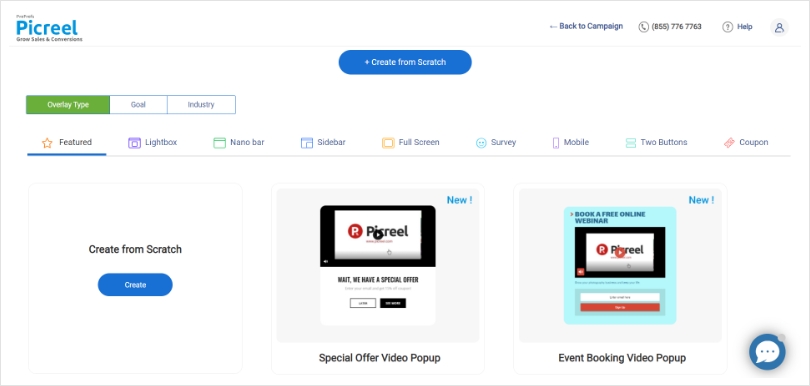
Exit Popups: Converting Abandoning Visitors
Exit-intent popups are the ones that appear on the screen when a user shows a clear intent to leave the website. The exit-intent popup then appears as an overlay to give something valuable to the abandoning user as an incentive to stay.
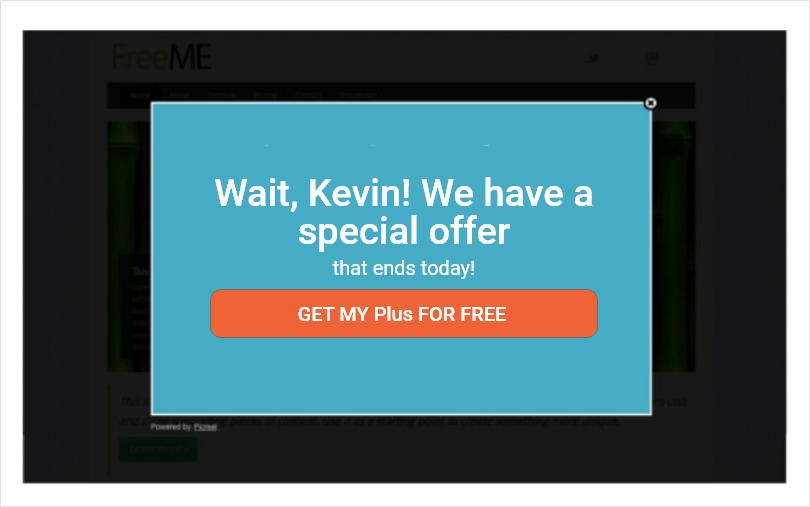
For instance, when a visitor navigates the cursor toward the corner of the screen, an exit-intent popup can automatically detect this movement as a sign of their intention to leave the website. It promptly responds by displaying a compelling popup to engage and retain the visitors, enticing them to stay and explore further.
With exit popups, you can instantly get the attention of your visitors, and when you have it, you should make the most of this opportunity.
Here, you can provide attractive deals and offers to your abandoning visitors, making it extremely hard for them to resist your offers. For instance, you can offer your visitors a flat 20% discount on their next offer or give free shipping on no minimum order value to make them stay.
So, you should only display the exit-intent popups once the visitor is about to leave because your motive here would be to entice them and make them stay longer.
Promotional Popups: Boosting Sales & Conversions
Promotional popups serve as powerful tools to capture attention, create urgency, and persuade visitors to take action.
One effective approach is to trigger popups based on user behavior, such as when visitors have spent a certain amount of time on a page or when they are about to exit the website. By displaying a well-timed popup offering a discount code, limited-time offer, or free shipping, you can motivate potential customers to make a purchase they might have otherwise hesitated to make.
Additionally, consider using popups strategically during key events, such as holidays or flash sales. By displaying targeted promotions during these high-traffic periods, you can leverage the heightened interest and capitalize on the urgency to drive conversions.
Signup Popups: Increasing User Registrations
Signup popups are a great way of collecting information about your audience. These forms allow you to gather personal information from your visitors, build email/SMS lists and also develop long-term relationships with them for better conversions in the long run.
But one thing to note is that simply asking for your visitor’s contact information is not exactly a great pitch because customers want something in return.
This is where you would need to make your popups extremely beautiful and alluring so that your visitors who see those popups are inclined to engage with them. Here, offering incentives like discounts and coupon codes can be extremely beneficial.
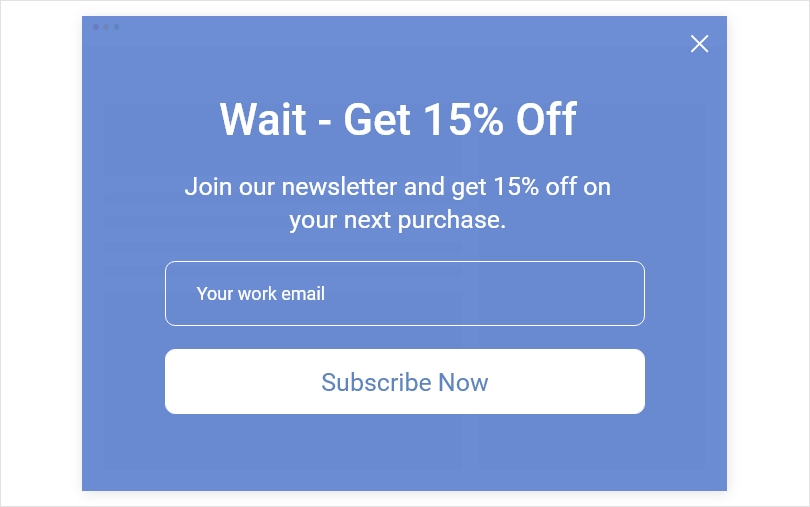
Also, another great way of ensuring that your popups generate great engagement is by targeting those popups to reach the right audience.
For instance, you can target your popups to only reach returning customers or those who have engaged to a certain extent, like specific page views or a certain amount of time.
By understanding the unique timing considerations for each type of popup, you can create a seamless and engaging user experience.
Time Your Popups Right for Higher Conversions
The best timing for popups will not only help you get more conversions but also improve your opt-in rates by preventing potential leads from dropping off.
Understanding your visitors is key in this process, as it allows you to tailor your popup designs and timing for optimal results. By observing, analyzing, and adapting, you can transform popups from mere interruptions into valuable interactions that engage and resonate with your audience.
To facilitate this, using a sophisticated online popup builder like Picreel is essential. With its features, you can create visually appealing popups and deploy them on your website with precise targeting, ensuring they reach the right people at the right time.
FREE. All Features. FOREVER!
Try our Forever FREE account with all premium features!

 We'd love your feedback!
We'd love your feedback! Thanks for your feedback!
Thanks for your feedback!




